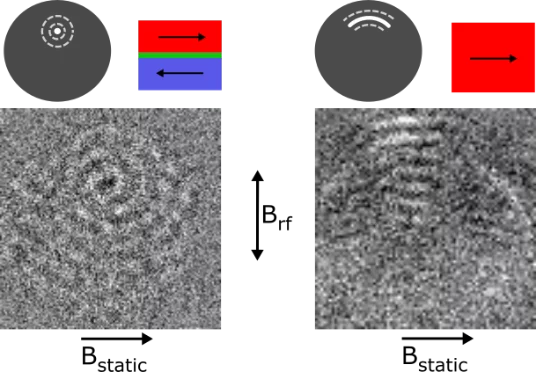In ferromagnetic materials, when the locally aligned spins precess with a spatially periodic phase shift, they form so-called spin waves. These spin waves provide promising means as signal carriers for future spintronic devices as they may allow further miniaturization of such devices. That is because the wavelengths of spin waves are orders of magnitude shorter than those of electromagnetic waves at the same frequency.
A typical way to excite spin waves is to use patterned antennas through which an alternating electric current is sent. To excite waves with even shorter wavelengths, a smaller antenna in the form of a naturally formed magnetic vortex core is used. In a magnetic vortex, the magnetic moments in a structured element are curling around the central point, the vortex core, the magnetization of which points out of the plane. These magnetic vortex cores can be driven by alternating magnetic fields to excite spin waves with ultrashort wavelengths. To be able to image such short-wavelength spin waves, the use of time-resolved scanning transmission x-ray microscopy (TR-STXM) is necessary.
Researchers from PSI together with collaborators from German, Czech and Finnish institutes, investigated the opportunities to manipulate such vortex-core spin-wave emitters by applying an additional magnetic field. They observed that a vortex core can be continuously displaced from its equilibrium position in the center of a disk structure while maintaining a driven spin-wave emission. For a single layer, an expansion of the vortex core is observed when it approaches the edge of the disk, while the extent of this expansion is controlled by the applied magnetic field. Such an expansion leads to a directional emission of the spin waves as well as the focusing. Such effects provide promising means for a controlled and directional propagation of spin waves to overcome the need for patterned waveguides.
Contact:
Dr. Jörg Raabe
Swiss Light Source
Paul Scherrer Institut
Telephone: +41 56 310 5193
E-mail: joerg.raabe@psi.ch
Original Publication:
Spin-Wave Emission from Vortex Cores under Static Magnetic Bias Fields
Sina Mayr, Lukáš Flajšman, Simone Finizio, Aleš Hrabec, Markus Weigand, Johannes Förster, Hermann Stoll, Laura J. Heyderman, Michal Urbánek, Sebastian Wintz, and Jörg Raabe
Nano Letters 21, 1584 (2021)
DOI: 10.1021/acs.nanolett.0c03740
